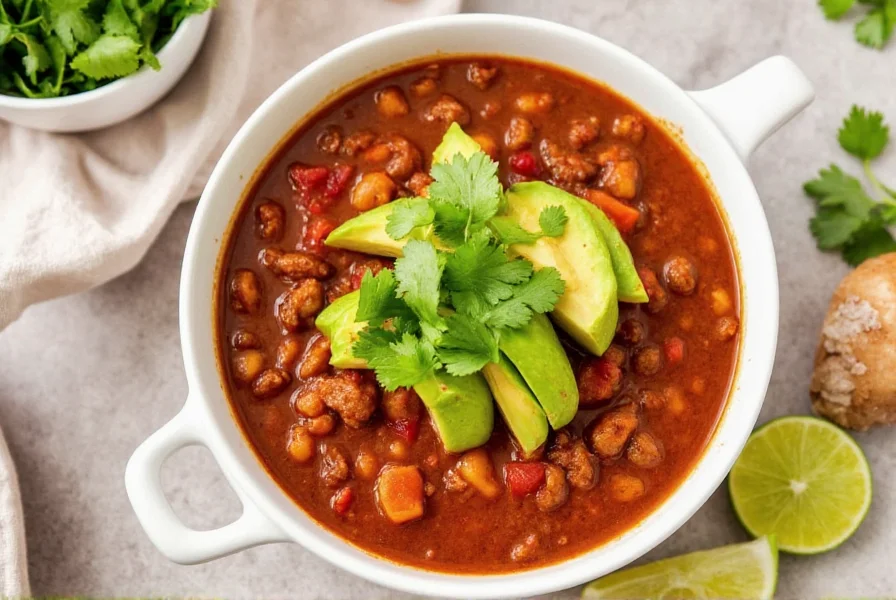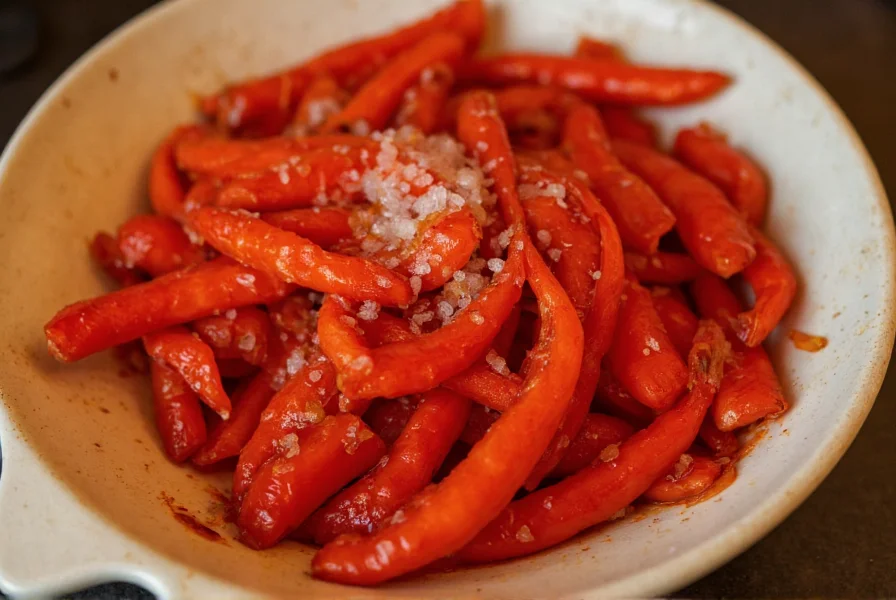Creating delicious low salt chili doesn't mean sacrificing flavor. Many home cooks mistakenly believe that reducing sodium automatically results in bland meals, but with the right approach, you can develop complex, satisfying flavors that actually highlight the natural taste of ingredients rather than masking them with salt. The key lies in understanding flavor chemistry and implementing specific cooking techniques that enhance taste perception without relying on sodium.
The Health Benefits of Low Sodium Chili
Reducing sodium in chili serves important health purposes, particularly for individuals managing hypertension or cardiovascular conditions. The American Heart Association recommends no more than 2,300mg of sodium daily, with an ideal limit of 1,500mg for most adults. Traditional chili recipes often contain 800-1,200mg of sodium per serving, primarily from canned beans, tomatoes, and seasoning mixes. By modifying ingredients and preparation methods, you can create a hearty chili with less than 300mg sodium per serving while maintaining robust flavor.
Flavor Science Behind Successful Low Salt Chili
Understanding how taste works is essential for creating satisfying low sodium chili. Salt enhances flavor perception by suppressing bitterness and amplifying other tastes, but you can achieve similar effects through other means:
- Umami boosters - ingredients like mushrooms, tomato paste, and roasted peppers create savory depth
- Acidic components - vinegar, citrus, or wine brighten flavors and create perception of saltiness
- Aromatic layering - properly sautéing onions, garlic, and peppers develops complex flavor compounds
- Spice blending - combining cumin, smoked paprika, and chipotle creates multidimensional heat
| Traditional High-Sodium Ingredient | Low-Sodium Alternative | Sodium Reduction |
|---|---|---|
| Regular canned beans (15oz) | No-salt-added beans | 400-500mg less per can |
| Regular canned tomatoes (15oz) | No-salt-added tomatoes | 300-400mg less per can |
| Pre-made chili seasoning mix | Homemade spice blend | 500-700mg less per serving |
| Soy sauce or Worcestershire | Coconut aminos or homemade alternative | 300-400mg less per tablespoon |
Essential Ingredients for Flavorful Low Salt Chili
The foundation of great low salt chili starts with carefully selected ingredients that naturally enhance flavor without sodium:
No-salt-added canned goods: Seek out "no salt added" or "unsalted" versions of beans and tomatoes. Rinse all beans thoroughly to remove any residual sodium from processing.
Fresh aromatics: Onions, garlic, celery, and bell peppers form the flavor base. Sauté these slowly to develop sweetness through caramelization rather than relying on salt for flavor enhancement.
Dried spices: Create your own blend using cumin, smoked paprika, oregano, and a touch of cayenne. Freshly ground spices provide more intense flavor than pre-mixed seasoning packets.
Umami powerhouses: Incorporate ingredients like dried mushrooms (soaked and finely chopped), tomato paste (cooked until darkened), and roasted red peppers to build savory depth.
Step-by-Step Low Salt Chili Recipe
This heart-healthy chili recipe serves 6 and contains approximately 280mg sodium per serving:
Ingredients
- 2 tbsp olive oil
- 1 large yellow onion, finely diced
- 4 garlic cloves, minced
- 1 red bell pepper, finely diced
- 2 celery stalks, finely diced
- 3 tbsp tomato paste
- 3 tbsp homemade chili seasoning (2 tbsp cumin, 1 tbsp smoked paprika, 1 tsp garlic powder, 1 tsp onion powder, ½ tsp black pepper, ¼ tsp cayenne)
- 2 (15oz) cans no-salt-added kidney beans, rinsed
- 1 (28oz) can no-salt-added crushed tomatoes
- 1 cup low-sodium vegetable broth
- 1 (4oz) can diced green chilies
- 1 tbsp apple cider vinegar
- 1 tsp liquid smoke
- Fresh cilantro for garnish
Instructions
- Heat olive oil in large pot over medium heat. Add onions, garlic, bell pepper, and celery. Cook slowly for 15-20 minutes until deeply caramelized.
- Add tomato paste and cook for 5 minutes, stirring frequently, until darkened.
- Stir in homemade chili seasoning and cook for 1 minute until fragrant.
- Add beans, tomatoes, broth, and green chilies. Bring to simmer.
- Reduce heat to low and cook uncovered for 45-60 minutes, stirring occasionally.
- Remove from heat and stir in apple cider vinegar and liquid smoke.
- Let rest for 15 minutes before serving to allow flavors to meld.
- Garnish with fresh cilantro.
Flavor Enhancement Techniques for Low Salt Chili
Professional chefs use several techniques to maximize flavor in low sodium cooking that you can apply to your chili:
The Maillard reaction: Properly browning your aromatics creates complex flavor compounds that mimic some effects of salt. Don't rush this step—low and slow cooking of onions, garlic, and peppers develops natural sweetness.
Acid balancing: Adding a small amount of acid (like apple cider vinegar or lime juice) at the end of cooking brightens flavors and creates the perception of saltiness without adding sodium.
Layering spices: Add dried spices at different stages—some when sautéing aromatics to bloom in oil, others later to preserve delicate flavors.
Resting time: Chili always tastes better the next day as flavors continue to develop. This is especially important for low salt versions, as the resting period allows flavors to meld and intensify.

Common Mistakes to Avoid in Low Salt Chili
Even experienced cooks make these errors when attempting low sodium chili:
- Overcompensating with heat: Adding too much cayenne or hot sauce to replace salt creates an unbalanced dish. Instead, focus on building complex flavors.
- Skipping the caramelization step: Rushing the sauté process prevents development of natural sweetness that replaces salt's flavor-enhancing properties.
- Using hidden sodium sources: Many ingredients like Worcestershire sauce, soy sauce, and even some vinegars contain significant sodium.
- Not adjusting seasoning at the end: Always taste and adjust acid and spice levels after the chili has finished cooking and rested.
Storage and Reheating for Maximum Flavor
Low salt chili often improves with storage as flavors continue to develop. Store in airtight containers in the refrigerator for up to 5 days or freeze for up to 3 months. When reheating:
- Gently warm on stove over medium-low heat
- Add a splash of low-sodium broth if needed
- Finish with a small amount of acid (vinegar or citrus juice) to refresh flavors
- Adjust seasoning with additional spices if necessary
Frequently Asked Questions
How can I make low salt chili taste as good as regular chili?
The secret to flavorful low salt chili lies in layering multiple flavor dimensions. Focus on caramelizing your aromatics thoroughly, using no-salt-added ingredients, incorporating umami-rich components like mushrooms and tomato paste, and finishing with a touch of acid like apple cider vinegar. Proper spice blending with cumin, smoked paprika, and a hint of cayenne creates complexity that replaces salt's flavor-enhancing properties.
What's the best salt substitute for chili?
Rather than using commercial salt substitutes (which often contain potassium chloride with a metallic aftertaste), focus on natural flavor enhancers. Create depth with roasted garlic, caramelized onions, mushrooms, and a splash of vinegar or citrus at the end. A small amount of nutritional yeast can add savory notes, and liquid smoke provides complexity without sodium. Remember that building flavor through proper cooking techniques is more effective than simply replacing salt with another single ingredient.
How do I reduce sodium in chili without losing flavor?
To maintain flavor while reducing sodium in chili, start with no-salt-added beans and tomatoes, then build flavor through proper technique. Sauté aromatics slowly until deeply caramelized, cook tomato paste until darkened, and layer spices at different cooking stages. Incorporate umami-rich ingredients like mushrooms and roasted peppers, and finish with a touch of acid. Allow the chili to rest for several hours or overnight, as flavors continue to develop and intensify during storage, reducing the need for salt.
Can I make low salt chili in a slow cooker?
Yes, you can make excellent low salt chili in a slow cooker, but with some modifications. First sauté and caramelize your aromatics on the stove to develop flavor, as slow cookers don't achieve the high temperatures needed for proper browning. Transfer these to the slow cooker with no-salt-added ingredients and cook on low for 6-8 hours. Add acidic components like vinegar during the last 30 minutes of cooking, as prolonged cooking can diminish their brightening effect. The slow cooking process helps flavors meld beautifully in low sodium chili.











 浙公网安备
33010002000092号
浙公网安备
33010002000092号 浙B2-20120091-4
浙B2-20120091-4